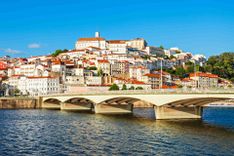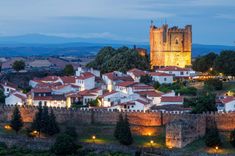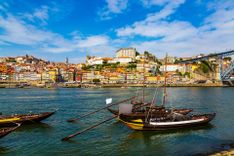Planning your own trip? Prepare for your trip
Use Rough Guides' trusted partners for great rates
Plan and book your private, tailor-made tour with vetted local experts
The Alentejo covers nearly a third of Portugal, stretching south from the River Tejo to the mountains of the Algarve. Its name literally means “beyond the Tejo,” and crossing into the region feels like stepping into a slower rhythm of life. The landscape is wide and open, shaped by wheat fields, cork oak forests, olive groves, and vineyards that seem to roll forever. Ancient dolmens, hilltop castles, and Roman ruins punctuate the plains, while the west coast hides some of Portugal’s wildest beaches.
The backbone of the region is its vast agricultural estates, the latifúndios, many of which trace their roots back to Roman times. Today, they support traditional farming and surprisingly rich wildlife. It’s not unusual to spot wild boar in the fields or see a great bustard lifting from the grasslands. If your tour of Southern Portugal takes you through the Alentejo, take it slow: distances are long, but the discoveries come often.

Hey, I’m Luis, your Portugal travel expert, and Alentejo is a region that asks you to slow down. Covering nearly a third of the country, it stretches from the River Tejo to the Algarve mountains, a landscape of rolling plains, cork oak forests, vineyards, and whitewashed towns that rise like islands from the fields. This Alentejo travel guide gives you the essentials: how to get there, when to go, and where to base yourself.
It’s best enjoyed unrushed. Spend a morning wandering through Évora’s Roman temple and medieval lanes, linger over lunch in a village square shaded by olive trees, or climb to Marvão’s castle for sweeping views across the borderlands. The big sights are obvious: Évora, Elvas, Monsaraz, but it’s often the details that stay with you: the smell of eucalyptus after rain, the sound of storks clattering on chimneys, the endless horizon at dusk.
Luis’s tip
Drive the backroads between villages rather than sticking to the highways. You’ll pass dolmens in fields, hidden chapels, and farmsteads that haven’t changed in generations.
Best time to visit
How to get to Alentejo
The easiest way to explore is by car. From Lisbon, Évora is about 1.5 hours, Beja is just over 2 hours, and Elvas is around 2.5 hours. Public transport exists, with trains and buses linking larger towns like Évora, Beja, and Elvas to Lisbon, but reaching smaller villages is tricky without your own wheels.
Best areas to stay in Alentejo
The Alentejo stretches across southern Portugal, covering nearly a third of the country. It runs south from the River Tejo to the northern mountains of the Algarve and east to the Spanish border. The region is vast, open, and mostly rural, with distances that can surprise first-time visitors. Évora, the regional capital, lies about 130 km east of Lisbon, around a 1.5-hour drive.
Often listed among the best places to visit in Portugal, the Alentejo combines history, culture, and nature in equal measure. From here, you can explore the Roman ruins and medieval streets of Évora, discover fortified border towns like Elvas and Marvão, or head west to the Costa Vicentina, a stretch of wild Atlantic coast that feels far removed from the Algarve crowds.

















Alentejo Coastline © Kingawo / Shutterstock
The Alentejo is Portugal’s biggest region, and distances between towns can be long. Public transport connects some of the larger hubs, but exploring properly almost always means having your own wheels. The reward is freedom: empty country roads, surprise dolmens in fields, and villages where time seems to have stopped.

Monsaraz castle and village, and hot air balloons, Alentejo - Portugal © Shutterstock
If you’re asking how many days in the Alentejo are enough, two or three will give you a taste: a wander through Évora’s Roman ruins and medieval streets, a drive across the cork-dotted plains, and perhaps a castle or vineyard stop along the way. It works well as a short add-on to a Portugal itinerary that already includes Lisbon, but that’s just scratching the surface.
If you have a week, you can dive deeper. Spend time in Évora, then explore the border fortresses of Elvas and Marvão, taste wine around Reguengos de Monsaraz, and head west to the wild beaches of the Costa Vicentina. Each part of the Alentejo feels different, from rolling plains to mountain ridges and rugged coast, so breaking your trip into sections works best.
The Alentejo is huge, so where you base yourself shapes the kind of trip you’ll have. From historic towns to vineyard estates and coastal villages, there’s a wide mix of stays. Here’s how to choose depending on your travel style.

Evora, Portugal @ Shutterstock
The Alentejo is too vast to “do” in a single trip. It’s a region best savored slowly, with time to let its rhythm sink in. Here’s a richer look at ten experiences that capture its history, landscapes, and way of life.
Évora is the Alentejo’s cultural capital and a UNESCO World Heritage city. The Roman Temple of Diana, built in the first century AD, is still remarkably intact, its Corinthian columns rising against the skyline. Nearby, Évora Cathedral dominates the old town. Part Romanesque, part Gothic, it invites you to climb onto the roof for a view that sweeps across orange-tiled rooftops and the vast plain beyond. Inside, the cloisters are cool and perfumed by orange trees, a perfect place to pause before plunging back into the streets. Around the square, cafés buzz with students and families, a reminder that Évora is very much alive beneath its layers of history.
The Capela dos Ossos is unlike anything else in Portugal. Built in the 16th century by Franciscan monks, its walls and pillars are covered with the bones of an estimated 5,000 people, arranged in neat, chilling patterns. At the entrance, a stark inscription reads: We bones that are here, await yours. It was intended as a memento mori, a reminder of the brevity of life. Standing inside, the effect is unsettling but oddly serene, a quiet space that encourages reflection rather than fear.
Outside, the adjoining church square hums with daily life, a striking contrast that makes the experience more powerful. Visit early if you want a contemplative atmosphere, or later in the day to watch how different visitors react to one of Portugal’s most haunting sights.
High above the Alqueva Lake, Monsaraz is a hilltop village that feels like a film set, all cobbled lanes, whitewashed houses, and castle walls overlooking endless water. The Alqueva is Europe’s largest artificial lake, but from Monsaraz it looks timeless, reflecting fiery sunsets in the evening. Inside the walls, you’ll find artisan workshops, wine cellars, and tiny squares where locals linger over coffee.
The castle still holds an open-air arena, once used for bullfights, now a stage for summer concerts. Stay after dark, when the day-trippers leave and the village glows in lamplight, and you’ll feel why Monsaraz is one of the most atmospheric places in Portugal.

Typical Alentejo houses in the Castle of Monsaraz © Joao Custodio/Shutterstock
Elvas is a fortified town on the Spanish border, and its walls are unlike any others in Portugal. Built in the 17th century, they spread out in a massive star pattern designed to resist cannon fire. Walking them is a lesson in military engineering: ravelins, bastions, and dry moats stretching as far as the eye can see. Inside the fortifications, Elvas is quiet, with tiled houses, shaded squares, and the monumental Amoreira Aqueduct, its arches marching across the landscape for eight kilometers.
The military museum explains centuries of conflict and resilience, but it’s the sheer scale of the fortifications that lingers longest. Stand on the ramparts at sunset, when the stone walls glow pink, and it feels as if the town is still standing guard.
Marvão clings to a granite ridge almost 900 meters high, its castle walls dropping steeply into the plains below. The view from the battlements takes in Portugal and Spain, with olive groves, cork forests, and distant peaks stretching in every direction. The village inside is small but beautiful: whitewashed houses, cobbled lanes, and gardens heavy with herbs. Silence is part of its charm. On a windy day, the sound of the breeze rushing through the battlements can feel louder than voices. Marvão rewards an overnight stay, when the crowds vanish and you can walk the walls under a sky crowded with stars.
The Alentejo is Portugal’s largest wine-producing region, and Reguengos de Monsaraz is at its heart. Here, vast herdades (estates) combine centuries-old tradition with modern cellars. A visit often includes a walk through cork oak groves and vineyards, followed by tastings of bold reds and crisp whites paired with local bread, olives, and cheeses. Some estates double as boutique hotels, so you can spend the night surrounded by vines, waking to misty fields and birdsong. Even if you’re not a wine expert, the hospitality is genuine, and you’ll come away with a deeper sense of how central wine is to Alentejo life.
Hidden in a cork forest outside Évora is one of Europe’s most important prehistoric sites. Almendres Cromlech is a circle of nearly 100 standing stones, older than Stonehenge and aligned with the solstices. Some bear faint carvings, their meaning still debated by archaeologists. Walking among them at dawn or dusk is powerful, when the stones cast long shadows across the clearing and the forest is silent except for birdsong. A short walk away lies a solitary menhir, a single stone standing watch over the plain. These megaliths remind you that the Alentejo has been sacred ground for thousands of years.

Marvão, Portugal @ Shutterstock
The Costa Vicentina, stretching down the western edge of the Alentejo, is one of Europe’s last wild coasts. The Rota Vicentina trail runs for hundreds of kilometers along cliffs, beaches, and dunes where you might walk for hours without seeing another soul. It’s often ranked among the best hikes in Portugal, thanks to its mix of raw Atlantic scenery, wildlife, and charming fishing villages.
Base yourself in Porto Covo, Vila Nova de Milfontes, or Zambujeira do Mar, where days end with grilled fish in simple seaside restaurants. Along the way, you’ll pass long sandy stretches that count among the best beaches in Portugal, many untouched by development and backed only by dunes and cliffs. Spring brings carpets of wildflowers, autumn has warm seas and quieter trails, and in any season, the Costa Vicentina shows you the Alentejo at its wildest.
The plains around Castro Verde are a paradise for birdwatchers. White storks nest on chimneys, pylons, and church towers, their clattering bills a constant soundtrack in summer. Out on the steppe, rarer species thrive: great bustards, one of the heaviest flying birds in the world, and birds of prey like eagles and kites. The town itself is low-key, with a baroque basilica at its heart, but the surrounding landscape is part of a Special Protection Area for birds. Even if you’re not a birder, the sight of storks gliding across the vast sky feels iconic of Alentejo.
The Alentejo has some of the clearest skies in Europe, and around the Alqueva Lake you’ll find the world’s first certified Dark Sky Reserve. With almost no light pollution, the Milky Way arches overhead on clear nights, and constellations are visible to the naked eye. Observatories in Monsaraz and nearby villages offer guided sessions with telescopes, but you can also simply drive out to the lake and look up. Summer nights are warm enough to linger for hours, while winter skies can be crisp and crystal-clear. Either way, stargazing here is a reminder of the Alentejo’s vastness, stretching not only across the land but into the heavens.

Rota Vicentina, Fishermen's trail, Portugal © Cat_s/Shutterstock
The Alentejo has a Mediterranean climate shaped by its inland plains and open horizons. Summers are long, hot, and dry, while winters are mild but wetter, with cooler nights than on the coast. Because the region is vast, conditions vary: Évora and Beja are hotter than the north, while the Costa Vicentina coast stays breezier and cooler. Average temperatures range from 45°F (7°C) in January to 95°F (35°C) in August, with heatwaves pushing it higher. For current conditions, check IPMA (Portuguese Institute for Sea and Atmosphere).

Alentejo plains: one of Portugal’s quietest regions @ Shutterstock
Eating in the Alentejo is as much a cultural experience as it is a meal. This is the land of hearty stews, black pork, and simple dishes elevated by olive oil, garlic, and bread. Restaurants range from family-run tascas hidden in narrow lanes to stylish vineyard restaurants on rural estates. Menus are rooted in tradition, portions are generous, and meals are often paired with bold local wines.

Alentejo forest, Portugal © RossHelen/Shutterstock
Here are some unique experiences we can arrange for your tailor-made Alentejo trip: all private, flexible, and designed by our local travel partners.
Discover Portugal's most captivating stories
Use Rough Guides' trusted partners for great rates
written by
Olga Sitnitsa
Online editor at Rough Guides, specialising in travel content. Passionate about creating compelling stories and inspiring others to explore the world.